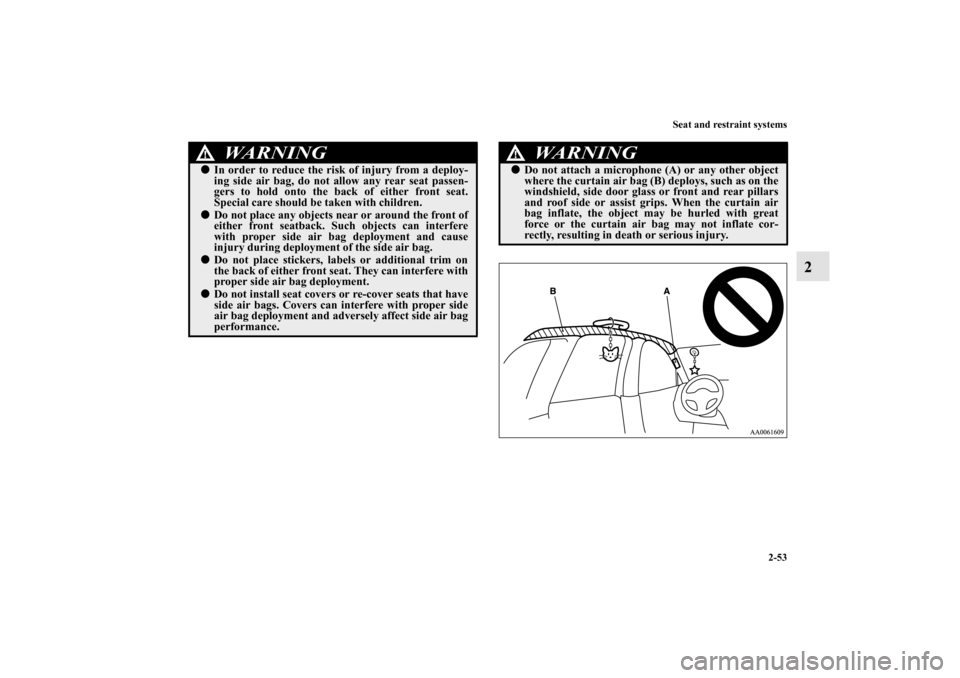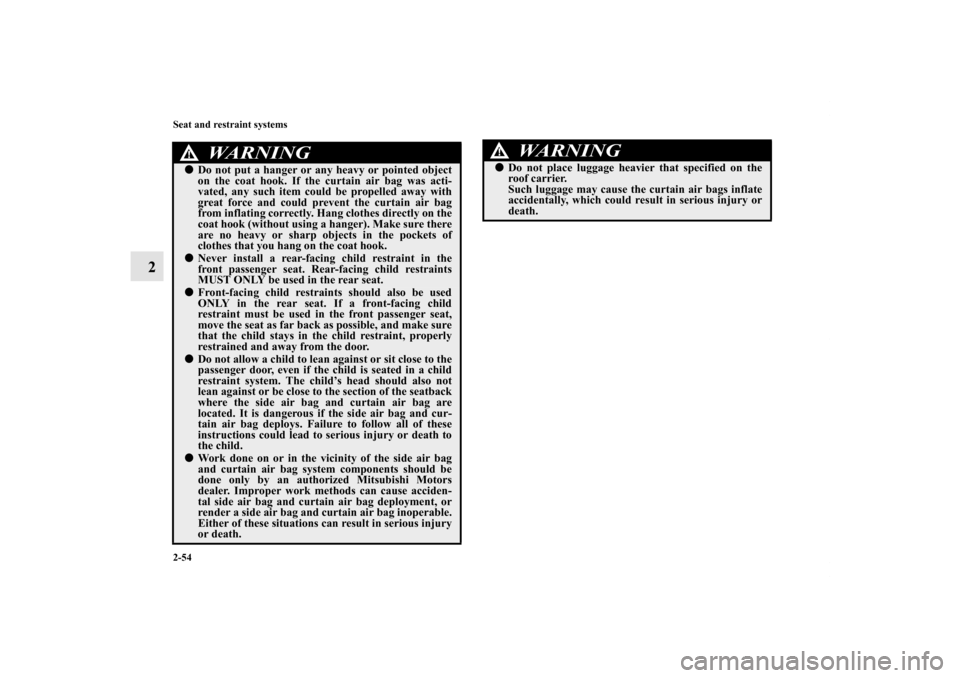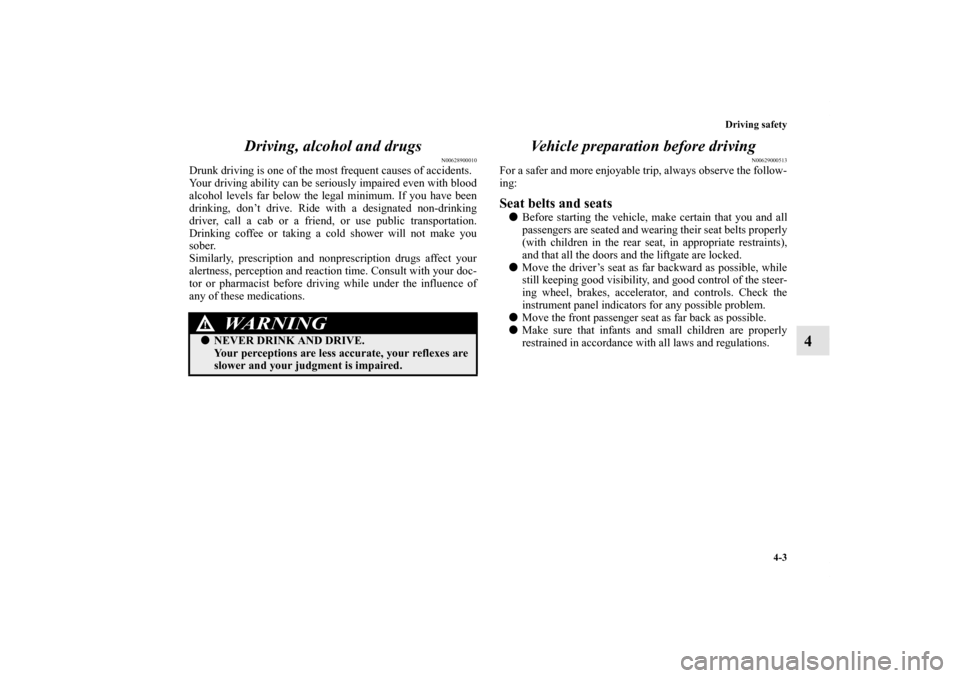Page 82 of 514

Seat and restraint systems
2-53
2
WA R N I N G
!�In order to reduce the risk of injury from a deploy-
ing side air bag, do not allow any rear seat passen-
gers to hold onto the back of either front seat.
Special care should be taken with children.�Do not place any objects near or around the front of
either front seatback. Such objects can interfere
with proper side air bag deployment and cause
injury during deployment of the side air bag.�Do not place stickers, labels or additional trim on
the back of either front seat. They can interfere with
proper side air bag deployment.�Do not install seat covers or re-cover seats that have
side air bags. Covers can interfere with proper side
air bag deployment and adversely affect side air bag
performance.
WA R N I N G
!�Do not attach a microphone (A) or any other object
where the curtain air bag (B) deploys, such as on the
windshield, side door glass or front and rear pillars
and roof side or assist grips. When the curtain air
bag inflate, the object may be hurled with great
force or the curtain air bag may not inflate cor-
rectly, resulting in death or serious injury.
BK0102600US.book 53 ページ 2009年3月30日 月曜日 午後2時2分
Page 83 of 514

2-54 Seat and restraint systems
2
WA R N I N G
!�Do not put a hanger or any heavy or pointed object
on the coat hook. If the curtain air bag was acti-
vated, any such item could be propelled away with
great force and could prevent the curtain air bag
from inflating correctly. Hang clothes directly on the
coat hook (without using a hanger). Make sure there
are no heavy or sharp objects in the pockets of
clothes that you hang on the coat hook.�Never install a rear-facing child restraint in the
front passenger seat. Rear-facing child restraints
MUST ONLY be used in the rear seat.�Front-facing child restraints should also be used
ONLY in the rear seat. If a front-facing child
restraint must be used in the front passenger seat,
move the seat as far back as possible, and make sure
that the child stays in the child restraint, properly
restrained and away from the door.�Do not allow a child to lean against or sit close to the
passenger door, even if the child is seated in a child
restraint system. The child’s head should also not
lean against or be close to the section of the seatback
where the side air bag and curtain air bag are
located. It is dangerous if the side air bag and cur-
tain air bag deploys. Failure to follow all of these
instructions could lead to serious injury or death to
the child.�Work done on or in the vicinity of the side air bag
and curtain air bag system components should be
done only by an authorized Mitsubishi Motors
dealer. Improper work methods can cause acciden-
tal side air bag and curtain air bag deployment, or
render a side air bag and curtain air bag inoperable.
Either of these situations can result in serious injury
or death.
�Do not place luggage heavier that specified on the
roof carrier.
Such luggage may cause the curtain air bags inflate
accidentally, which could result in serious injury or
death.
WA R N I N G
!
BK0102600US.book 54 ページ 2009年3月30日 月曜日 午後2時2分
Page 301 of 514

4-2 Driving safety
4Driving precaution
N00629300040
Utility vehicles have higher ground clearance and a narrower
track, which enables them to perform in a wide variety of off-
road situations. Because of the higher ground clearance, these
vehicles have a higher center of gravity, which makes them
handle differently than ordinary vehicles when driving on
pavement. They are not designed to maneuver or corner at the
same speed on pavement as conventional 2-wheel drive pas-
senger cars any more than low-slung sports cars are designed
to perform satisfactorily in off-road conditions.
Always drive safely and steer the vehicle carefully. Avoid oper-
ating the vehicle in a manner that might require sharp turns or
abrupt maneuvers. As with other vehicles of this type, failure
to operate this vehicle correctly can result in loss of control or
vehicle rollover.
In a rollover crash, an unbelted person is significantly more
likely to die than a person wearing a seat belt. Before starting
the vehicle, always make certain that you and all your passen-
gers are properly wearing their seat belts (with children in the
rear seat, in appropriate restraints).
Fuel economy
N00628800080
Fuel economy is dependent on many factors. Your personal
driving habits can have a significant effect on your fuel use.
Several recommendations for achieving the greatest fuel econ-
omy are listed below.
�Whenever accelerating from a stop, always accelerate
slowly and smoothly.
�When parked for even a short period, do not idle the
engine. Shut it off.
�Plan your trips to avoid unnecessary stops.
�Keep your tires inflated to the recommended pressures.
�For freeway driving, maintain a speed of approximately
50 mph (80 km/h) when traffic, roadway and weather con-
ditions safely permit.
�Keep your air filter clean and your vehicle lubricated
according to the recommendations in this manual.
�Always keep your vehicle well maintained. A poorly
maintained engine wastes fuel and costs money.
�Do not overload your vehicle.
WA R N I N G
!�Utility vehicles have a significantly higher rollover
rate than other types of vehicles. Avoid abrupt
maneuvers and excessive speed. Always buckle up.
BK0102600US.book 2 ページ 2009年3月30日 月曜日 午後2時2分
Page 302 of 514

Driving safety
4-3
4 Driving, alcohol and drugs
N00628900010
Drunk driving is one of the most frequent causes of accidents.
Your driving ability can be seriously impaired even with blood
alcohol levels far below the legal minimum. If you have been
drinking, don’t drive. Ride with a designated non-drinking
driver, call a cab or a friend, or use public transportation.
Drinking coffee or taking a cold shower will not make you
sober.
Similarly, prescription and nonprescription drugs affect your
alertness, perception and reaction time. Consult with your doc-
tor or pharmacist before driving while under the influence of
any of these medications.
Vehicle preparation before driving
N00629000513
For a safer and more enjoyable trip, always observe the follow-
ing: Seat belts and seats�Before starting the vehicle, make certain that you and all
passengers are seated and wearing their seat belts properly
(with children in the rear seat, in appropriate restraints),
and that all the doors and the liftgate are locked.
�Move the driver’s seat as far backward as possible, while
still keeping good visibility, and good control of the steer-
ing wheel, brakes, accelerator, and controls. Check the
instrument panel indicators for any possible problem.
�Move the front passenger seat as far back as possible.
�Make sure that infants and small children are properly
restrained in accordance with all laws and regulations.
WA R N I N G
!�NEVER DRINK AND DRIVE.
Your perceptions are less accurate, your reflexes are
slower and your judgment is impaired.
BK0102600US.book 3 ページ 2009年3月30日 月曜日 午後2時2分
Page 507 of 514

Alphabetical index
2Service brake 3-53
Warning light 3-83
Break-in recommendations 3-2
Bulb capacity 7-44
C
California Perchlorate Materials Requirements 1-9
Capacities 9-8
Cargo loads 4-12
Catalytic converter 7-3
Cautions on the handling of all-wheel drive vehicles 3-51
Certification label 9-4
Charging system warning light 3-85
Child restraints 2-25
Child safety locks for rear door 3-15
Cleaning
Inside of your vehicle 7-58
Outside of your vehicle 7-60
Clock 3-197
Coat hook 3-210
Combination headlights and dimmer switch 3-153
Consumer information 8-2
Coolant (engine) 7-9
,9-8
Cruise control 3-63
Indicator 3-64
Cup holder 3-206
D
Defogger (rear window) 3-163Digital clock 3-197
Dimensions 9-4
Dimmer (high/low beam change) 3-156
Disc brake pads 7-33
Dome light
Bulb capacity 7-46
Replacement 7-55
Switch 3-200
Door lights 3-202
Bulb capacity 7-46
Replacement 7-57
Doors
Locks 3-13
Power door locks 3-15
Warning light and buzzer 3-85
Drive belt 7-33
Driving during cold weather 4-5
Driving precaution 4-2
Driving, alcohol and drugs 4-3
E
Electric rear window defogger switch 3-163
Electronic immobilizer (Anti-theft starting system) 3-3
Emission-control system maintenance 7-31
Engine
Block heater 3-39
Compartment 7-6
Coolant 7-9
,9-8
Coolant temperature gauge 3-81
BK0102600US.book 2 ページ 2009年3月30日 月曜日 午後2時2分